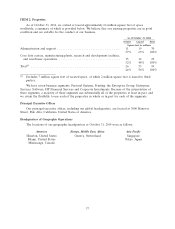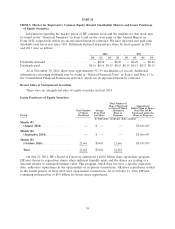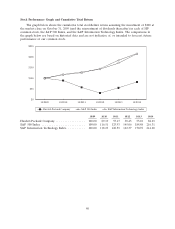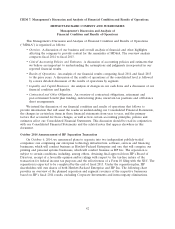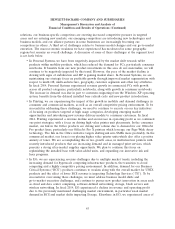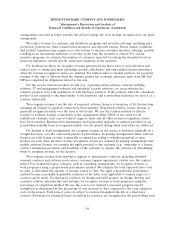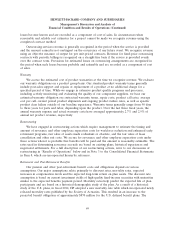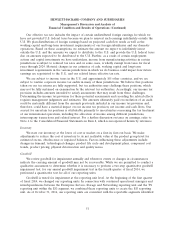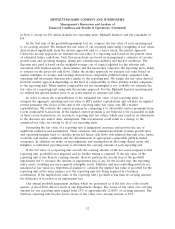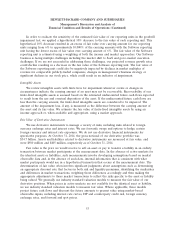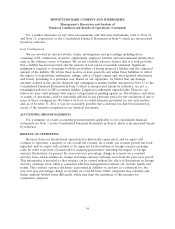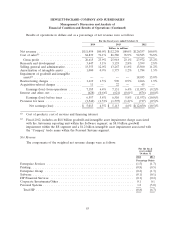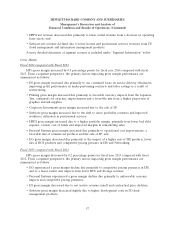HP 2014 Annual Report Download - page 55
Download and view the complete annual report
Please find page 55 of the 2014 HP annual report below. You can navigate through the pages in the report by either clicking on the pages listed below, or by using the keyword search tool below to find specific information within the annual report.HEWLETT-PACKARD COMPANY AND SUBSIDIARIES
Management’s Discussion and Analysis of
Financial Condition and Results of Operations (Continued)
A summary of significant accounting policies is included in Note 1 to the Consolidated Financial
Statements in Item 8, which is incorporated herein by reference. An accounting policy is deemed to be
critical if it requires an accounting estimate to be made based on assumptions about matters that are
highly uncertain at the time the estimate is made, if different estimates reasonably could have been
used, or if changes in the estimate that are reasonably possible could materially impact the financial
statements. Management believes the following critical accounting policies reflect the significant
estimates and assumptions used in the preparation of the Consolidated Financial Statements.
Revenue Recognition
We recognize revenue when persuasive evidence of an arrangement exists, delivery has occurred or
services are rendered, the sales price or fee is fixed or determinable and collectibility is reasonably
assured, as well as other revenue recognition principles, including industry specific revenue recognition
guidance.
We enter into contracts to sell our products and services, and while many of our sales agreements
contain standard terms and conditions, there are agreements we enter into which contain non-standard
terms and conditions. Further, many of our arrangements include multiple elements. As a result,
significant contract interpretation may be required to determine the appropriate accounting, including
the identification of deliverables considered to be separate units of accounting, the allocation of the
transaction price among elements in the arrangement and the timing of revenue recognition for each of
those elements.
We recognize revenue for delivered elements as separate units of accounting when the delivered
elements have standalone value to the customer. For elements with no standalone value, we recognize
revenue consistent with the pattern of the associated deliverables. If the arrangement includes a
customer-negotiated refund or return right or other contingency relative to the delivered items and the
delivery and performance of the undelivered items is considered probable and substantially within our
control, the delivered element constitutes a separate unit of accounting. In arrangements with
combined units of accounting, changes in the allocation of the transaction price between elements may
impact the timing of revenue recognition for the contract but will not change the total revenue
recognized for the contract.
We establish the selling prices used for each deliverable based on vendor-specific objective
evidence (‘‘VSOE’’) of selling price, if available, third-party evidence (‘‘TPE’’), if VSOE of selling price
is not available, or estimated selling price (‘‘ESP’’), if neither VSOE of selling price nor TPE is
available. We establish VSOE of selling price using the price charged for a deliverable when sold
separately and, in rare instances, using the price established by management having the relevant
authority. TPE of selling price is established by evaluating largely similar and interchangeable
competitor products or services in standalone sales to similarly situated customers. ESP is established
based on management’s judgment considering internal factors such as margin objectives, pricing
practices and controls, customer segment pricing strategies and the product life cycle. Consideration is
also given to market conditions such as competitor pricing strategies and industry technology life cycles.
We may modify or develop new go-to-market practices in the future, which may result in changes in
selling prices, impacting both VSOE of selling price and ESP. In most arrangements with multiple
elements, the transaction price is allocated to the individual units of accounting at inception of the
arrangement based on their relative selling price. However, the aforementioned factors may result in a
different allocation of the transaction price to deliverables in multiple element arrangements entered
into in future periods. This may change the pattern and timing of revenue recognition for identical
47


